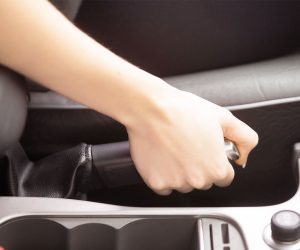Emergency Stop
You should be able to stop the car promptly and under control as in an emergency and then move off under control when safe to do so.
Throughout your driving test your aim will be to slow down in good time and pull up gently, except in the emergency stop exercise, which will show your competence in taking immediate and effective action.
The emergency stop will be conducted at random during one–in–three car tests to enable extra time to be spent in normal driving.
The first thing that must be said is that an emergency stop situation should not arise because an alert driver who is looking well ahead and concentrating on the job of driving will seldom, if ever, have to perform an emergency stop. However having said that we are only human, a moment’s un-attention could mean that a situation is not read correctly and the only way to avoid an accident may be to stop quickly.
The Examiner will ask you to stop at various places during the driving test. Whenever you stop, you should do so in a safe place. It’s during one of these ‘stops’ that the Examiner will ask you to stop the vehicle as if in an emergency. The Examiner will hold up their right hand and say ‘Stop’.
This is the one occasion in the test when you don’t follow the mirrors–signal–manoeuvre routine. Before giving you the signal to ‘Stop’ the Examiner would have checked the road behind. They won’t ask you to stop if there could be a danger from following traffic. Remember also that you should in any case have an idea what is behind you with frequent checks as you are driving along.
Because this is an emergency priority must be given to prompt action, this means moving your foot as quickly as possible to the footbrake. It is important to remember to apply the footbrake first and then just before you stop push the clutch down. Leaving the clutch until the very end allows the engine to assist with the braking. Pushing the clutch down too soon will disengage the engine from the drive wheels and the car will lose the engine braking effect. When you put your foot on the brake pedal you should brake progressively harder to avoid the wheels from locking. Obviously the intention is to stop quickly but if you lock the wheels the car can skid and then you will have very little control and it may take even longer to stop. Should the wheels lock during the braking procedure then use what is referred to as ‘Cadence Braking’ which involves momentarily releasing the brake and immediately re–applying it. This will allow the tyres to regain their grip. Modern cars have ABS (antilock brake system) so the car will cadence brake for you.
While you are braking you should keep both hands on the wheel to give you the greatest possible control over the steering. You should make sure that you keep the wheel straight, do not try to steer while you are braking as this could also induce a skid. Keep both hands on the wheel until the car has fully stopped. When you have come to a halt apply the handbrake and go into neutral. You will realise that having stopped under these circumstances your vehicle will be out in the road. Before moving off you should look in the mirrors and around over both shoulders (to include the blind spot) to make sure that it is safe to move off.
Remember: Not looking over your shoulders before moving off is one of the easiest ways to pick up a driving fault; you are usually so pleased that you brought the car to a stop without skidding that you simply forget. Don’t let this happen!

The Driving Test
The examiner on the driving test will expect you to:-
- Stop the car promptly
- Keep the car under control without locking the wheels
- Stop the car in the shortest possible distance
- Stop the car without endangering other road users
- Use proper all-round observation before moving off again
